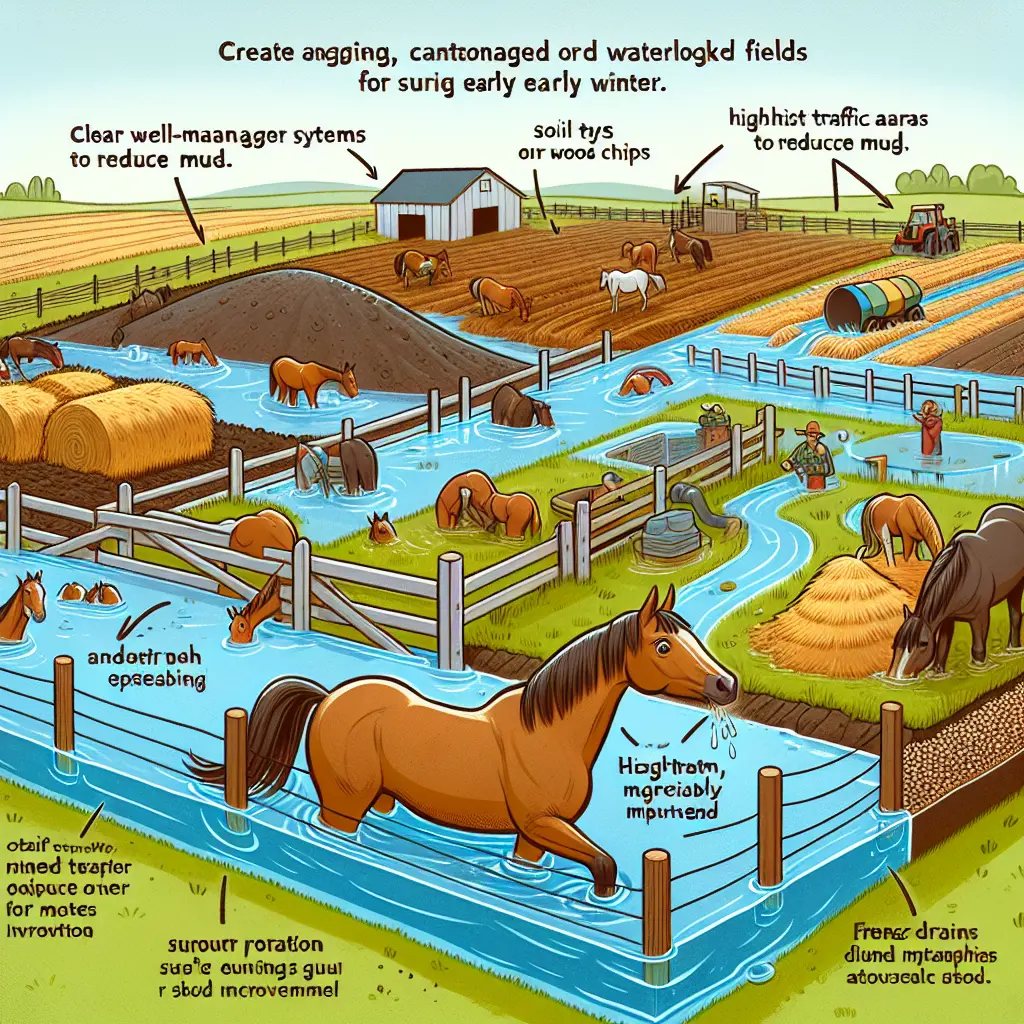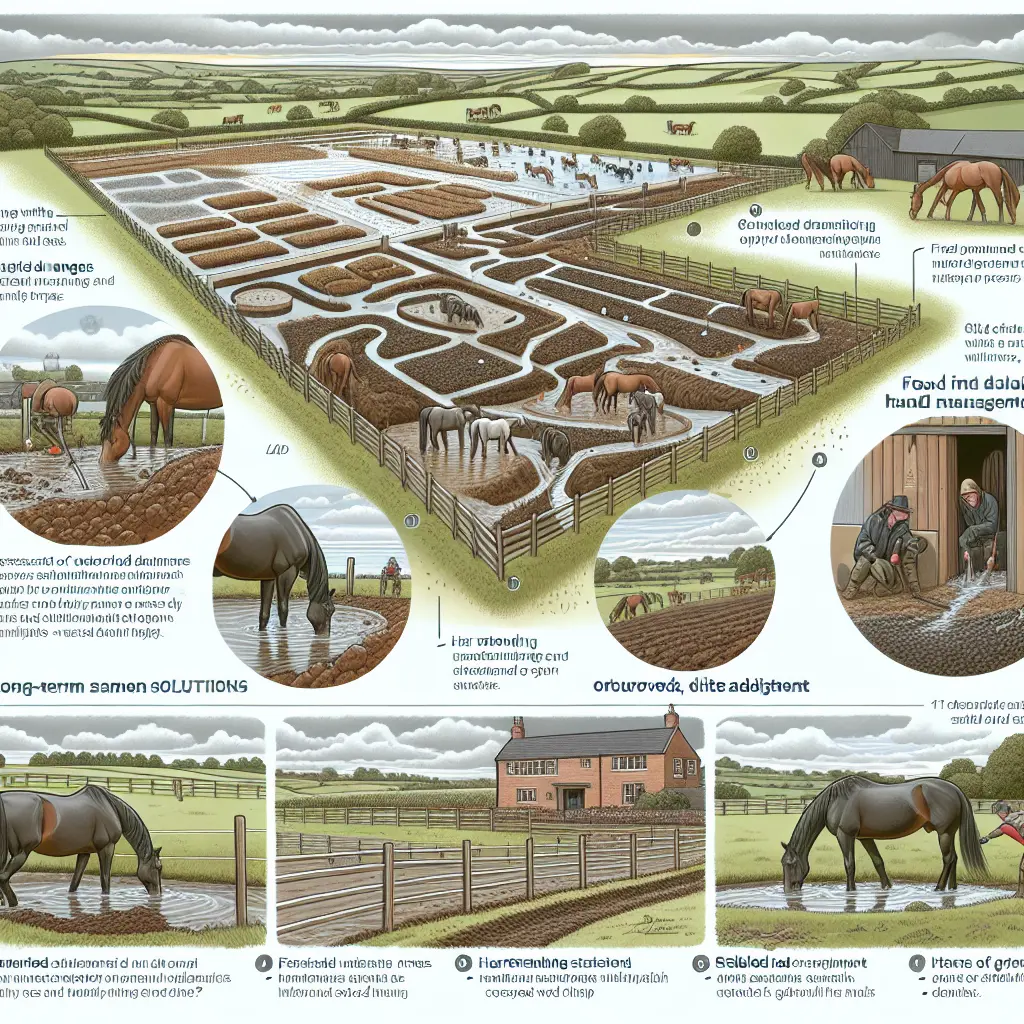Managing Waterlogged Fields: Strategies and Tips for Horse Owners Facing Early Winter Challenges
As the days grow shorter and the temperature drops, many horse owners face the dreadful anticipation of waterlogged fields and the challenges they bring. These soggy conditions can wreak havoc on both the health of horses and the integrity of the land. In this article, we will explore effective strategies and tips for managing wet fields, ensuring both your horses and land remain in peak condition.
Preparing for Wet Weather
Assessing Your Land
 Before the winter weather sets in, it's vital to assess the drainage of your land. Identifying areas that gather water and ensuring current drainage systems are free of debris can go a long way in preventing waterlogging[1]. If you notice particularly saturated soil, it might be time to consider installing drainage solutions such as French drains[2].
Before the winter weather sets in, it's vital to assess the drainage of your land. Identifying areas that gather water and ensuring current drainage systems are free of debris can go a long way in preventing waterlogging[1]. If you notice particularly saturated soil, it might be time to consider installing drainage solutions such as French drains[2].
Implementing Mud Management Strategies
 Mud is not only messy, but it poses serious risks to horse health. One effective way to combat it is by creating hardstanding areas using materials like horse-safe woodchips. Position these strategically around gates and heavy traffic areas to reduce erosion and mud buildup[2].
Mud is not only messy, but it poses serious risks to horse health. One effective way to combat it is by creating hardstanding areas using materials like horse-safe woodchips. Position these strategically around gates and heavy traffic areas to reduce erosion and mud buildup[2].
Managing Horses During Wet Weather
Providing a Safe Environment
Ensuring that your horses have a safe, well-drained area is crucial in wet weather. If possible, relocated them to higher ground[3]. Temporary fencing, such as electric fence tape, can be an effective way to create new enclosures quickly without permanent alterations.
Dietary Considerations
Horses, like humans, need plenty of water, especially in cold weather. Ensure they have access to clean water at all times and consider adding moisture to their diets by soaking hay or making feeds sloppy[4]. Keep an eye out for skin conditions that thrive in damp environments, such as mud fever[4].
Regular Exercise and Monitoring
 To prevent stiffness and maintain cardiovascular health, regular exercise is key. Even short daily walks can be beneficial, keeping horses limber and healthy. Monitoring body condition is important too; winter weight gain can lead to health issues [4].
To prevent stiffness and maintain cardiovascular health, regular exercise is key. Even short daily walks can be beneficial, keeping horses limber and healthy. Monitoring body condition is important too; winter weight gain can lead to health issues [4].
Long-Term Solutions
Pasture Rotation and Soil Improvement
Implementing a pasture rotation system not only maximizes space but also allows fields to recover during harsh conditions[2]. Once the wet season concludes, consider harrowing and overseeding with native grasses that have deeper root systems to improve soil structure[2].
Enhancing Drainage
 Investing time into enhancing drainage will save effort in mud cleanup and keep your fields healthier. For instance, adding gravel can help deflect runoff in high-traffic zones[3], while deeper drainage systems have been known to reduce not only mud but also the occurrence of infections in stagnant water[4].
Investing time into enhancing drainage will save effort in mud cleanup and keep your fields healthier. For instance, adding gravel can help deflect runoff in high-traffic zones[3], while deeper drainage systems have been known to reduce not only mud but also the occurrence of infections in stagnant water[4].
Managing waterlogged fields might seem daunting, but with these proactive strategies in place, it becomes a more manageable task. By combining proper planning, soil management, and horse health maintenance, you can enjoy a winter with fewer worries, ensuring the well-being of both your horses and your land.
For further reading on managing equestrian environments and equipping your horses for winter, check out our collections of stable rugs, turnout rugs, and our wide range of everyday horse vitamins & supplements.
Conclusion
By staying informed and prepared, horse owners can overcome the challenges that come with waterlogged fields, ensuring their horses remain healthy and their land stays resilient. Remember, proactive planning and regular field assessments go a long way in tackling the wet season head-on.
If you found these tips useful, please explore our additional product collections to further support your equestrian needs throughout the year.
For more expert tips and advice, visit Just Horse Riders and explore a world of equestrian excellence.

